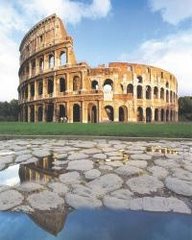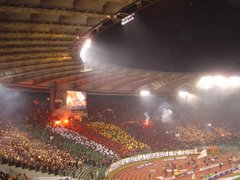Medieval Rome
It is not easy to find artistic remainders of the Middle Ages in Rome, also because they are often incorporated into buildings built during later periods, or hidden in places rarely visited by the occasional tourists. In addition to the ancient, Renaissance or Baroque city, there is also a medieval Rome with its monuments and works of art which can, in part, be discovered through this itinerary.
Of the numerous churches built in the Middle Ages in Rome, around 40 remain with their original appearance. And of the 300 existing towers, we can count 50 of them, many of which are absolutely unknown because they are hidden by the buildings against which they stand.
In the Middle Ages Rome was obviously smaller than it is today, and extended along the Tiber, a fundamental resource for water supply and as a communication route. In the Trastevere quarter, along the right-hand riverbank, there are still churches and residential buildings dating from the Middle Ages.
The visit may thus begin from the Isola Tiberina and end in the heart of Trastevere, in Piazza Santa Maria in Trastevere.
On the Isola Tiberina today it is still possible to admire what remains of the Castle of the Caetani, built against the Torre dei Pierleoni dating from the 10th century. In 1087 Matilde di Canossa and Pope Victor III hid in the tower to escape the dangers of the army of the antipope Clement II and, in 1089, Pope Urban II resided there. The Caetani became the owners of the fortress in around 1294, the year Benedetto Caetani was elected pope with the name Boniface VIII. The tower, which today is still at the head of the Ponte Fabricio, is also known as the Torre della Pulzella (Tower of the Maid), referring to the small marble head of a young woman set into the brick facing.
The towers were residences and fortresses of the aristocratic families, and symbols of their power. Down through the years, many of the tower-houses suffered damage from earthquakes or were torn down as ordered by Senator Brancaleone degli Andalò in 1252. With the Renaissance, the residential palace style took hold, and the towers were incorporated into the new buildings or else totally demolished.
Inside the Church of San Bartolomeo all'Isola, before the steps of the presbytery, is one of the most important medieval pieces of the church: a marble puteal or well curb created from a Roman column fragment.
It is one of the very few pieces of Ottonian art found in Rome, In fact, it dates from the 10th century, from the time of Otto III, who probably commissioned it- To the left of the church façade rises the Romanesque bell tower, built in the 12th century.
From the Isola Tiberina it is possible to reach the Piazza in Piscinula with the Casa Mattei, an elegant complex of 14th-century dwellings built for the noble Roman family and restored, during the Fascist period, by Lorenzo Corrado Cesanelli.
On the ground floor of the building several rooms were occupied by the inn called "della Sciacquetta".
The Romanesque poet Trilussa lived for a certain period in the building on the corner of Via della Lungarina.
From Piazza in Piscinula we take the Via Arco dei Tolomei which takes its name from the medieval arch which can still be seen, even if it has been considerably reworked.
The monument was erected for the noble Sienese family who lived in this quarter from the 14th century. From Via Arco dei Tolomei we turn onto Via dei Salumi ("of the Cold Cuts": like many streets of the quarter, it owes its name to the trades of the shopkeepers), from which the picturesque Vicolo dell'Atleta starts.
The Vicolo dell'Atleta is so named because the Apoxyomenos statue ("The Scraper": an athlete scraping off the sweat and dust mixed with the oil with which he was coated before the fight) was found there in 1849. The sculpture, a 1st century A.D. Roman copy of a Greek original by Lysippus, is now kept in the Vatican Museums.
Atno.14 of Vicolo dell'Atleta we can see a pretty 13th-century construction, with a loggia and small pointed arches on stone corbels, and with an inscription in Hebrew on the central column. It is considered the only surviving ancient Jewish synagogue in the quarter, which was populated by a sizeable colony of Roman Jews in the Middle Ages.
In this zone of Rome, the centre of the oldest Trasteverine folklore, people danced the "saltarello", a typical dance from the regions of Abruzzo and Ciociaria dating from the 14th century.
Each year since 1535, the traditional "Festa de Noantri" ("Festival of Us Others", i.e. the citizens of Trastevere as opposed to "voantri", the "you others" of the other quarters) is held, dedicated to Our Lady of Carmine, whose feast-day falls on 16 July. The religious feast-day is supported by the civil festivities which include concerts, sports competitions, and various attractions, ending with a display of fireworks.
Going back to Via dei Genovesi we can take Via di Santa Cecilia which leads into the square dominated by the church of the same name. Across from the entrance to the Basilica of Santa Cecilia, at the corner of Piazza dei Mercanti there is a lovely example of a 14th-century house.
The church of Santa Cecilia, considerably changed down through the centuries, has a beautiful Gothic tabernacle executed by Arnolfo di Cambio in 1293, and precious 9th-century apse mosaics. The monks' choir holds the famous fresco with the Last Judgement by Petro Cavallini, the greatest Roman painter of the late 13th century.
Once again going back to Via dei Genovesi we arrive in Piazza Sonnino, which has one of the most well-know medieval constructions: the Torre degli Anguillara, better known as the "House of Dante".
The fortress, consisting of a crenellated wall which, strengthened by a tower, enclosed dwellings and stables, dates from the 13th century. Enlarged in the 15th century by Count Everso II, the building was heavily restored in the 19th century. Since 1914 it has been the seat of the "House of Dante", a cultural institution that promotes studies on the poet.
Near the square is the church of San Crisogono, one of Trastevere's great medieval basilicas. In the apse is a 13th-century mosaic erroneously attributed to Pietro Cavallini.
The bell tower, 5 storeys tall, was built ca. 1120 by order of the church's cardinal, Giovanni da Crema, who also had the basilica built.
Going all the way down Via della Lungaretta swe arrive at the square of Santa Maria in Trastevere, one of Rome's medieval gems (see Itinerary 2). The apse contains the famous mosaics with the Coronation of the Virgin, executed in 1143, and the Stories of the Virgin done by Pietro Cavallini in the 13th century.
To the left of the apse is the Altemps Chapel, containing the 6th-century Our Lady of Mercy, one of the oldest images of the Virgin arriving up to the present day.
The church allegedly stands over the Taberna meritoria where, in 38 B.C., a miraculous eruption of oil took place, interpreted later as an annunciation of the birth of Jesus. The first church in the city dedicated to the cult of the Virgin was thus founded on the site of the miracle in the 4th century. In reality, more than a miracle, the eruption was caused by the natural emission of oil from the ground.
This quarter, fairly tranquil during the daytime, at night becomes populated with Romans and foreigners seeking a place to eat and have fun. An excellent pizza can be enjoyed at Da Ivo, at Via San Francesco a Ripa 158 (06 5817082), or you can eat at Gildo, at Via della Scala 31/A (06 5800733). In Piazza di Santa Maria in Trastevere there is the restaurant Sabatini, a true institution in the quarter (06 5812026). In any case, almost all places propose excellent selections, suitable for all tastes and wallets!
Length of itinerary: about 4 hours.
Practical advice: The itinerary takes place on foot. We recommend taking it in the afternoon, in order to be able to end the day with a meal in a typically Roman restaurant.












